
iPad Air 4th Generation review
(CNN) —
Unlike the eighth-gen iPad that only got some retooling under the hood with the A12 Bionic chip, Apple gave the latest iPad Air a full face-lift and rethinking. For starters, the home button is gone and the screen stretches fully to the edges, delivering a 10.9-inch display.
And after five days with it, we’re really liking the iPad Air — especially with a starting price of $599.99 for 64GB of storage, it’s a great option for anyone looking to go beyond what an entry-level iPad can do. The 10.9-inch screen feels expansive and gives you plenty of room for multitasking. And for movie nights, this display excels at color reproduction. We also found that the A14 Bionic chip lets you breezily accomplish nearly any task.
Sure, the iPad Air might seem like a mishmash of different features, but it also plants itself as midrange. There’s no Face ID or a remarkable refresh rate with this display like you’d find on an iPad Pro. But select higher-end features have trickled down, and the iPad Air (in this form) feels like the Pro option for the masses.
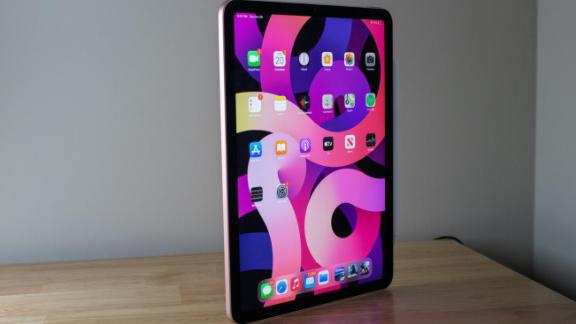
As the name hints, the iPad Air is known for being ultra portable. It’s very comfortable to hold in just one hand even with its nearly 11-inch screen. The 2020 iPad Air measures in at just over a pound, so it’s lighter than a bottle of water. And its thickness (6.1 millimeters) is akin to four credit cards stacked atop each other.
The Air’s aluminum design really lets the respective colors (Sky Blue, green, silver and Space Gray) shine as light hitting the backside at different angles displays a brighter or darker hue. The Smart Connector is on the back for easy pairing with accessories like the Smart Keyboard. Atop the Air is a spot where you can magnetically attach a second-generation Apple Pencil. Like on the iPad Pro, this not only holds the Apple Pencil in place but will wirelessly charge it. It’s nice to see this feature trickle down from the iPad Pro.
There’s also no Lightning port on the iPad Air; Apple has swapped in a USB-C port to replace it, and we’re fully on board with it. To a degree, it’s a more Pro port with support for charging, data transfers and even the ability to extend your display.

Our favorite part of the design would be that Apple tucked a Touch ID sensor into the power button. It’s the first time Apple’s featured a fingerprint sensor on an iPad’s home button. On the engineering side of the house, the power button’s outer shell is a glass finish, which contains the smaller fingerprint sensor that Apple has produced.
In our testing, Touch ID was just as fast in this new form as in a home button. If anything, most of the time it felt about a half second or so faster. Just more prompt for unlocking, authenticating purchases and autofilling passwords.
Face ID is a lot easier, as you don’t really need to do anything except look at the True Depth Sensor at the top of the iPad, but it’s also clear that Apple is reserving that tech for its flagship iPads. We imagine that Face ID on the iPad Air would have jacked the price up. All in all, though, we’re happy with this implementation of Touch ID, and it only took us a day to really get the hang of it.
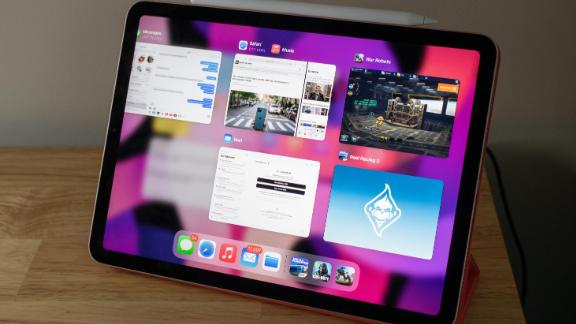
In comparison to the previous generations of iPad Air, Apple is giving you a slightly larger display — a 10.5-inch is swapped for a 10.9-inch. The big difference to get that 0.4-inch increase? Removing the home button and slimming down the bezels.
And while 0.4 inches is a relatively small increase, in combination with this refreshed design and slimmer bezels, the iPad Air feels more expansive. You can more comfortably fit two apps side by side with a picture-in-picture window for consuming content.
The display is Liquid Retina, which is Apple’s name for an LCD screen. Essentially, it’s not being lit on a pixel-by-pixel basis like an OLED, but rather it has a backlit panel that goes through filters to create an image. Still, it creates a vivid and sharp image at a 2360 x 1640 resolution that delivers 264 pixels per inch. It also supports True Tone and, especially good for creatives, it meets the Wide Color P3 standard.
Apple tries to minimize finger smudges across the screen with a fingerprint-resistant oleophobic coating, which we found certainly succeeds at hiding a majority of fingerprints, although potato chip fans are warned — overly greasy fingers will still leave a mark and sometimes residue. The screen also features an anti-reflective coating, which aids in helping to block views of smudges, especially under fluorescent lights or outside.
In our testing period, text came through crisp, and we didn’t notice any pixelation around individual numerals or letters, a problem that often plagues some lower-end screens and even LCDs. Viewing emails and reading text on the iPad Air was comfortable on the eyes, thanks to True Tone.
With streaming content, we tried out Springsteen’s “Letter to You” documentary, which arrives on Apple TV+ on October 23. It’s part studio sessions, panning outdoor shots and the E Street Band together all in black and white. The iPad Air reproduced the picture with proper color shading across grays and blacks for a compelling experience. In comparison to watching on an iPad Pro, you’d be hard-pressed to really notice a difference in image quality.
And while this doesn’t have ProMotion (an adaptive refresh rate that goes up to 120 Hz), we didn’t notice any milling or issues with production. That same comment also extends to gaming in Real Racing 3 and War Robots or with watching superhero movies like “Captain Marvel” or “Guardians of the Galaxy.”
We’d also like to call out the stereo speakers that flank the left and right sides when the iPad Air is held horizontally. They pack a punch and deliver a pretty robust sound experience that’s only bested by the iPad Pro. We didn’t experience any additional noise or tinny audio effects, either.
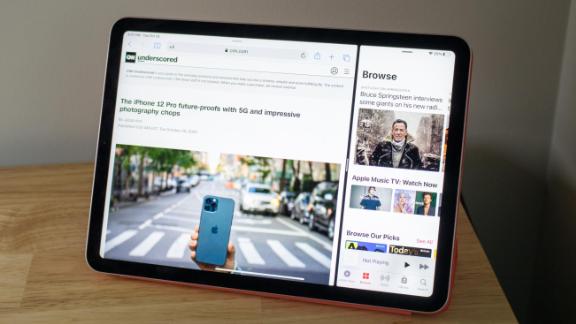
The iPad lineup has a clear entry point with the eighth-gen iPad and a high point with the iPad Pro. With the A14 Bionic inside, the iPad Air really cements itself as the midrange option — a next step above the eighth-gen iPad not quite up to scale with the iPad Pro with the A13Z inside.
For instance, you can run through a series of photo edits in Photoshop or Pixelmator (two leading editing apps) at three or four times the speed as the eighth-gen iPad. And by meeting that mark, the iPad Air falls nearly in line with the iPad Pro — thanks to Apple’s latest Silicon processor inside.
The A14 Bionic is also being used in the iPhone 12 Mini, 12, 12 Pro and 12 Pro Max. It’s the first 5-nanometer chip made in-house by Apple. Inside it contains a six-core CPU, four-core GPU and a neural engine that’s made up by 16 cores. Safe to say it’s a powerful chip that’s also quite efficient and knows when to speed up or put intense tasks on a higher-powered core.
And thanks to this setup, the iPad Air outpaces the previous-generation device — the eighth-gen iPad — and the iPad Mini with nearly any workflow or task. From gaming to writing to communication, the iPad Air just gets the job done faster.
In many cases, we found it to be nearly on par with the iPad Pro for completing those tasks. When we used it for a day of work with Outlook, Mail, video calls, Slack, web browsing and lots of writing, we didn’t experience any slowdowns. For instance, with multitasking, it was easy-going for running two applications side by side and a third, like Messages, floating above.
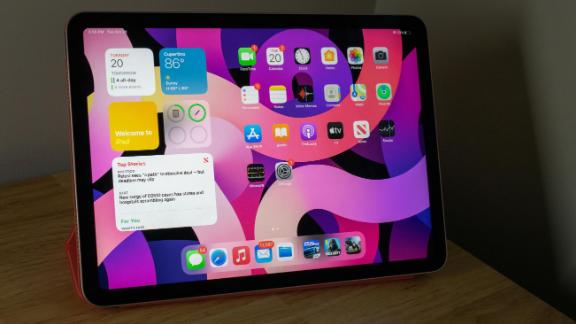
Graphic- and processor-intense games like War Robots, Real Racing 3 and Call of Duty: Mobile performed as expected. There was no noticeable latency occurring either on the device or via the internet. The only qualm we experienced here was at full brightness and volume at max, the power did drop by about 5% during the first match in Call of Duty. It might have been that it was the first time playing, which could have pulled in extra resources. That proved true again when using Shadow, a service that lets you remotely use a high-powered PC for games like Microsoft Flight Simulator and Grand Theft Auto V.
Rendering and exporting a 4K video in iMovie happened pretty quickly, with no noticeable slowdowns. It produced a result much quicker than the eighth-gen iPad by several minutes. We also pushed the iPad Air with Adobe Photoshop and Pixelmator in an effort to engage the neural engine for tasks and processes that involve Machine Learning.
The iPad Air also works with the Magic Keyboard (specifically, the smaller model, which originally launched for the 11-inch iPad Pro). It snaps magnetically onto the iPad Air and adds the same function (with the same weight and thickness). If you want a computer-like experience complete with a trackpad, this is the best experience for now on the iPad Air. The keyboard feels just as great as it did when we reviewed the Magic Keyboard a few months back.
The connection between Magic Keyboard and iPad Air is still powered by the Smart Connector on the back. It’s extremely simple and doesn’t require you to fumble around in settings and manage multiple power cords. The A14 Bionic inside is plenty to handle inputs from your fingers and the Pencil, let alone a keyboard and trackpad as well.
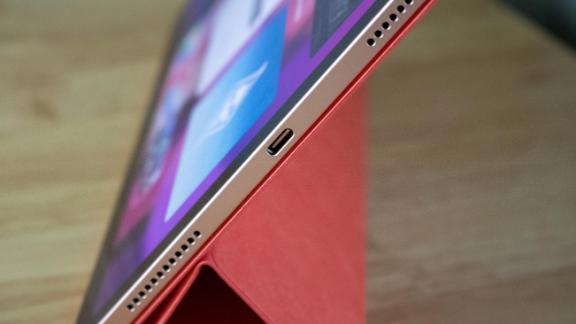
Unlike the iPhone 12 family, the box doesn’t just include a USB-C to USB-C cable along with the iPad Air. But there’s a 20-watt USB-C wall plug here as well, and it’s great news. This is the same $19 brick that Apple recommends purchasing for fast charging on the iPhone 12. We’re thrilled it comes in the box on the iPad and it gives you the complete package right out of the gate.
And that brings us to the battery on the iPad Air — and truthfully it has been great over the past five days. We’ve encountered long standby times and the joy of it providing enough power to get through a full day. Even when those days drag on with some videos, FaceTime calls and gaming.
Apple promises around 10 hours of surfing the web on Wi-Fi or when watching a video. And we ran the iPad Air through the CNN Underscored battery test. With this we run a 4K video on a loop with the brightness set to 50%, the volume at 30% and airplane mode engaged on the device. We monitor the test with two cameras for redundancy. The iPad Air lasted for six hours and 45 minutes. That’s behind the eighth-gen iPad, which lasted for nine hours and 45 minutes.
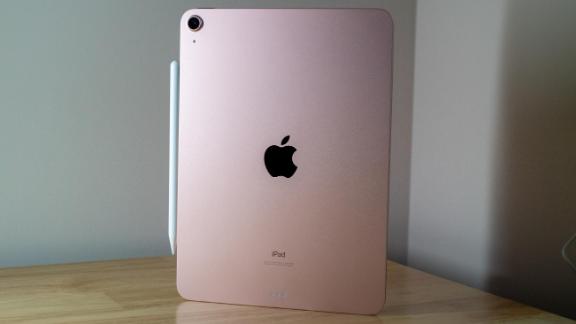
There’s a chance you might have been sold on this iPad Air from the start, or maybe when we wrote about the color choices. It’s a bold design that feels like it can hang with the flagships, and the hardware inside means it can generally hang and stay for a while with them.
The iPad Air performed up to Pro levels. With the A14 Bionic inside, we were easily able to perform work and play tasks. For those productivity-centric tasks, pairing it with the Magic Keyboard gave us the affordance of classic interfaces to work with — namely a keyboard and trackpad. It runs iPadOS 14 well and can speed up for more intensive tasks.
At $599.99 for 64GB of internal storage, you’re getting a pretty complete package with plenty of storage for apps and documents as well. Whether you’re a student, a remote worker or someone looking to upgrade from an entry-level tablet, the iPad Air deserves a look.
















